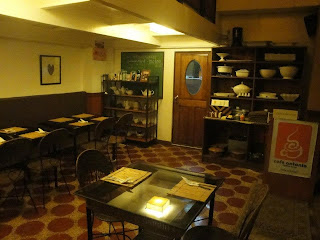Yesterday, we conducted our first free coffee workshop of the year with special guest barista, Lanz Mirondo from Singapore.
Kimmy Baraoidan, one of our coffee junkie participants, blogged about her experience during the workshop:
Lanz Mirondo’s Barista Workshop
Today I went to a free coffee workshop facilitated by coffee connoisseur and professional barista Lanz Mirondo at Cafe Antonio.
Despite the heavy rains brought about by typhoon Odette, attendance was
quite good. At the start of the workshop, the participants were each
asked to share their expectations. Most of us expected to taste
different kinds of coffee and to widen our coffee palate. But we got
much, much more than that.

Lanz Mirondo explaining the mechanics of the cupping (taste test).
The first activity was cupping or taste
test. For this activity, Lanz brought six kinds of coffee for us to
taste: 1) Brazilian San Antonio, 2) Tobing Estate (Indonesia), 3) El
Salvador, Nevada, Yirgacheffe, Ethiopia, 4) Dark Horse, 5) Crompton
Road, and 6) Don Pepe, Panama. There are five things to keep in mind
when evaluating coffee: aroma, body, flavor, acidity, and finish. Aroma
is the smell of coffee beans or grounds. Fragrance is the smell of
coffee mixed with water. Body is the coffee’s viscosity (is it light or
dense?). Flavor is what the coffee tastes like. Acidity is the degree of
sourness. Finish (short or long) is the lack or presence of an
aftertaste.

Some of the coffee blends we tasted at the workshop.
First we smelled the ground coffee, then smelled the coffee after
being mixed with hot water, then tasted the coffee. Tasting coffee is
very much similar to tasting wine. One has to slurp it, not just sip it.
The louder, the better. Slurping ensures maximum distribution to the
tongue’s taste buds because it sprays the coffee to the back of the
tongue. After swirling the hot liquid in your mouth, you can either
swallow it or spit it. In my case, I spat the coffee out because I get
palpitations if I drink too much coffee in a day. It is important to
drink water in between tastes in order to cleanse the palate. To our
untrained noses and tongues, at first, the coffee blends all seemed to
smell and taste the same. But as we went around the table several times,
we were able to distinguish the nuances of each blend.

Workshop participants smelling the coffee grounds and taking down notes.
We were also required to take notes while smelling and tasting. We
had to describe what we smelled and tasted as accurately as we could.
One good point raised by Lanz and by Jabez (Cafe Antonio’s senior
barista) is that each of us would have different descriptions of the
smell and taste. It would depend on our life experiences and on our
exposure to different kinds of food and drink. True enough, when we were
asked to share our notes, each person used different words to describe
the smell and taste. I’m a photographer and I think visually most of the
time. In my notes, I had put “yellow” and “bright” to describe the
tastes of two different coffee blends. It was also apparent what type of
coffee each of us liked based on our favorites. Mine are Dark Horse and
Crompton Road (the much stronger ones).
Next, Lanz and Jabez demonstrated three types of coffee preparations:
French press, drip, and AeroPress. They only used one type of coffee
blend and made us taste the coffee that went through the different types
of preparations. Each preparation method produced a different taste.
The French press produced a stronger and bolder taste and a denser
liquid. The drip produced a lighter liquid and a milder taste. It
brought out the sweetness of the blend. The AeroPress is a recent
innovation which combines the French press and drip methods. The taste
is a middle ground brought by the fusion of the two methods. For me, I
prefer the French press because I really like my coffee strong.

Left: French press; right: drip method

Left: coffee made using the French press; right: coffee made using the drip method.

The AeroPress method.
Lanz then opened the floor for questions and comments from the
participants. We were all impressed by his refined palate and knowledge
about not only coffee making but about the coffee industry as well. He
shared his experience working as a barista in Singapore and the rather
funny encounters he had with non-Filipino customers. He then proceeded
to make some coffee at Cafe Antonio’s espresso machine, and we all
watched him work his magic. He continued to entertain questions and to
tell stories while making coffee like a boss. This guy is brimming with
wisdom and experience – a true coffee guru.

Lanz grinding coffee.
There is so much more that I took away from the workshop. I engaged
Lanz in a more in-depth conversation, which I will make into another
story soon. All I can say for now is that good, old hard work, an open
mind, a can-do attitude, and an unquenchable thirst for learning are
keys to Lanz’s success.
(More photos of the workshop here.)
Source: http://kimmeh13.wordpress.com/2013/09/23/lanz-mirondos-barista-workshop/


















































